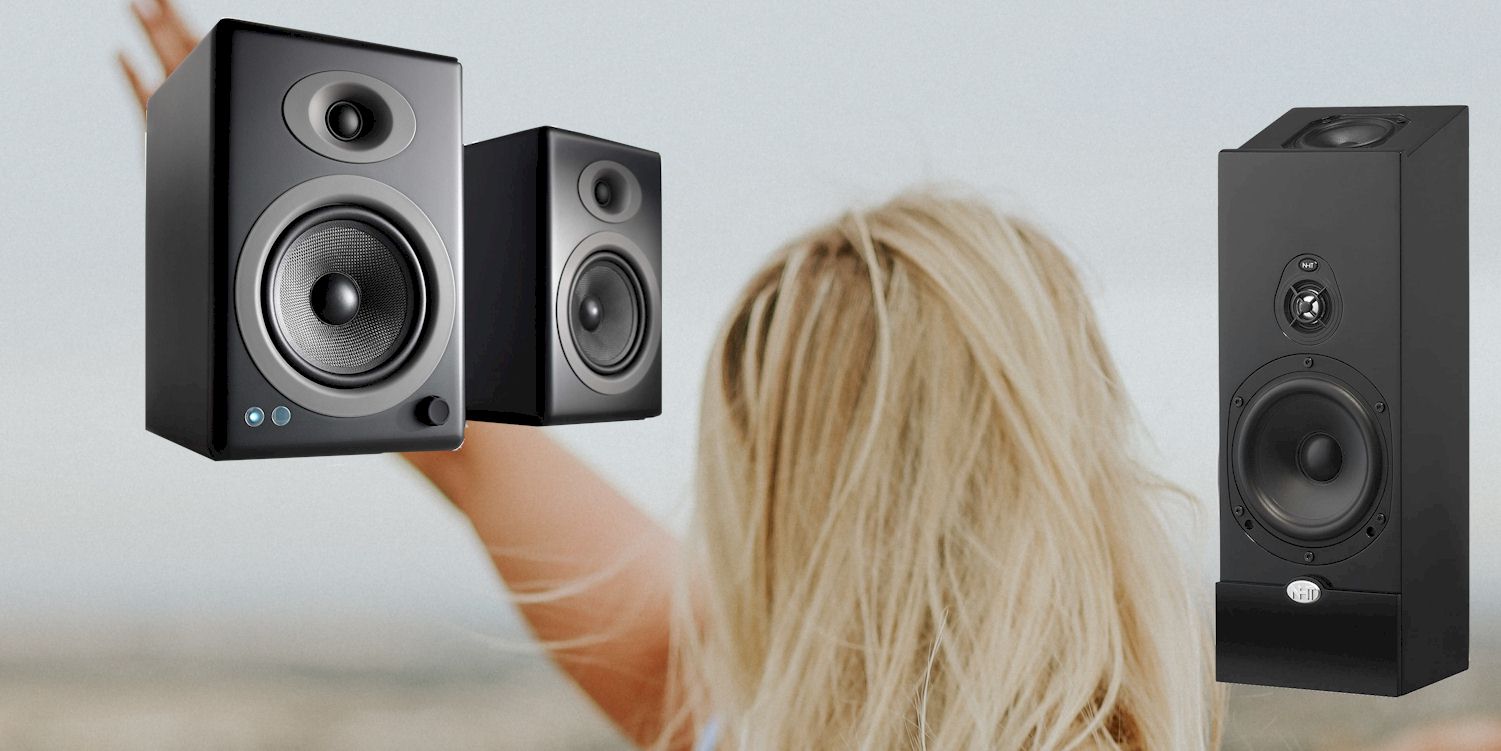The satellite vs. bookshelf speakers for surround sound debate continues to rage on. Satellite and bookshelf systems are home theater options that have polarized so many people over the years. Appreciating their differences will help you make the right choices for your speaker conundrum.
From sonic integrity to room-space management, we will see how these two favorites stack up against one another.
Ready for the ride? I am.
Contents
What are satellite speakers and bookshelf speakers?
Satellite speakers
Satellite speakers or satellites are small loudspeakers placed by the side and behind the listener's listening position.
There are two forms of satellites, "2.1" and "5.1." The figure before the dot indicates the number of satellite speakers, while the figure behind the dot refers to the subwoofer. A 2.1 speaker will deliver stereo sound, while the 5.1 will deliver multichannel sound with improved audio monitoring. With this, it's not hard to decipher what a satellite means - an addition to the main speakers.
Bookshelf speakers
As the term implies, bookshelf speakers are speakers resting on shelves. They can also be placed on elevated planes like tables or stools, but not the floor. Bookshelf speakers are designed to optimize music in small- to mid-sized areas and are ideal if your living room doesn't have a lot of square feet.
Compact and space-efficient, stand-mount speakers are compatible with your smartphone, TV, computer. They also connect to HDMI and Bluetooth.
You may desire a wireless or wired bookshelf speaker option, but keep in mind that each has its drawbacks. While a wireless speaker prevents placement clutter, you may not fully enjoy your sonic set when your Wifi or Bluetooth signal shows weak strength.
Related: Ported vs Sealed Subwoofer
Satellite Speakers vs. Bookshelf Speakers: the differences between them
Sound quality
Satellite speakers are recognized by their pleasant surround sound effects, making them a jewel among movie lovers. Conversely, bookshelf speakers have a sonorous acoustic bandwidth, making them lovable for music-listening purposes.
Size
As you can already imagine, satellite speakers are significantly smaller than their bookshelf counterparts. You'll find that some are less than 6" in height. Bookshelves, on the other hand, are larger and serve superbly as front speakers.
Frequency range
Satellites emit excellent mid-bass and mid-range frequencies. But, you can't use them at less than 100 Hz as they usually generate between 150 to 200Hz. Since they focus mainly on higher frequencies, satellites are most suitable for supplementing central speakers.
On the flip side, bookshelves full-range speakers, boasting a broad range. In every package, you will find high- and low-frequency drivers - a perk allowing you to play music without attaching subwoofers and still hit top-shelf quality. Frequencies range from 20 kHz to 50 Hz, while some blare at 120 Hz.
Placement
We already know that satellite speakers are meant to be positioned on the sides or at the rear of the listening area. However, due to their small stature and weight, you may place them anywhere you deem fit.
Musical capability
Satellite systems are terrific when producing surround sound, a prerogative that makes them more suited for films than bookshelf speakers. Contrarily, bookshelves are superior when the time comes to get melodic.
Related: Edifier r1700bt Bookshelf Speaker
When to choose a satellite over a bookshelf
Acquire a satellite when you're searching for a system that's:
- Easier to merge with a sound system
- Smaller, niftier, and can be placed anywhere
- Inexpensive
- They are designed to blend with most interiors without appearing out of place.
- They are designed to "assist" bigger speakers, especially as surrounds.
When to choose a bookshelf over a satellite
Acquire a bookshelf when you're out looking for a speaker that's:
- Made to upscale your home theater set up. They work well as the height and frontal speakers. Known for versatility, bookshelves can be used as surrounds.
- Built to handle all ranges: lows, mids, and highs. Product usually features built-in subs.
- Designed to blare out louder volumes than a satellite.
Examples of satellite speakers
Time for a roundup of some of the most popular satellite speakers out there: Bose satellite speakers and Klipsch satellite speakers.
Bose satellite speakers fulfill your dreams of creating cinematic quality sound in your home. Wireless, the system delivers impressive surround sound to make you feel as though you were in the middle of the action. Specs include:
- 30 feet wireless range
- Auxiliary connectivity
- 0 channel
Klipsch Reference Premiere Theater Pack 5.1 Satellite Speakers
Fix your gaze on Theater Pack 5.1, a high-fidelity home theater speaker system comprising a wireless sub you can connect to your AV receiver. Don't overlook this teeny tiny receiver if you want a system with:
- Flexible placement
- Cinematic sounds with minimized distortions
- True to source bass accuracy via the wireless subwoofer
Examples of bookshelf speakers
Klipsch R-15M bookshelf speakers
Klipsch R-15Ms are two small but mighty speakers built to deliver the best home audio experience possible. Minimalist in design, this medium saturates listeners in their favorite music and movies for long stretches of audio pleasure. Apart from filling your tiny room with vibrant, lifelike sound, R-15:
- It weighs just 10 pounds
- Has over 1,000 happy-customer Amazon reviews
- Treats you to a 5.2" copper-based, high-energy woofer
Edifier R1280T bookshelf speakers
What do you call a product scoring 12,000 reviews? Market leader! True to its staggering numbers, Edifier R1280T never fails to deliver. It delivers a boomy midrange, sure to enchant any listener. Built-in tone control and RCA inputs let you connect several audio devices.
- 4" bass driver
- Very affordable
- It doubles up as a studio monitor
- Remote control available
Summing it all up
Trust you to appreciate by now all there is to know about satellite vs. bookshelf speakers for surround sound. Satellite speakers offer benefits unlike bookshelves do, and vice versa.
As a rule of thumb, when there is no extra space in your sitting room, but you have got a decent amount of furniture, then you may order a bookshelf. But, if you have a prominent speaker you would like to attach to your new speaker as a supporting act, then maybe you should consider satellites.
In the end, please do your due diligence and find out which one works best for your spatial and lifestyle needs. Cheers!

HI, John Andrew here. I’ve been an audiophile since I was a little kid. I’m an original member of myaudiolover . It emerged as a way for me to share my passion and knowledge for audio technology. If you’re looking for tips, techniques, and insights about audio-tech, that can enable your productions that professional edge, then MyAudioLover is the place for you!

